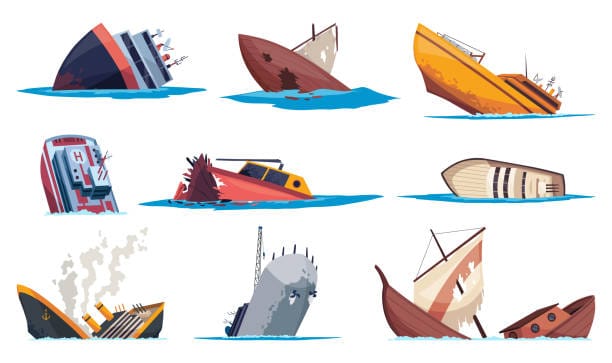A tragic accident took place in the warm waters off the resort city of Hurghada in Egypt‘s Red Sea on March 27, 2025, when a tourist submarine overturned just a kilometer off the coast. The vessel, the *Sindbad*, carried 40 passengers, the majority of them tourists, when it went down. At least six people were reported dead and many others injured according to the latest reports. The victims included five Russian nationals among the dead minors and one national whose nationality is not disclosed. The cause of the accident is still under investigation but is raising frightening questions about maritime tourism safety in the region.
Details of the Tragic Accident

The Sindbad submarine, belonging to and operated by Sindbad Submarines, was providing a routine underwater tour to visitors on board. The submarine had set out in the morning, providing visitors with a glimpse of the colorful sea life beneath the waves of the Red Sea. All this was however made tragic at around 10:00 AM local time when the vessel suddenly sank.
The authorities say rescue teams attended quickly, arriving at the scene within minutes. Rescuers managed to pull several survivors from the water and transported them to local hospitals, although the outlook is serious, with some of the dead reported in critical condition. The remains of the deceased were recovered shortly after the ship had sunk, and their identities are being closely verified by local authorities. Among the victims are several members of a Russian family who were on vacation in Egypt. The investigators are trying to determine the precise circumstances of what occurred and whether there was any foul play or equipment failure involved.
A Growing Concern for Tourist Submarine Safety

The Sindbad submarine tragedy serves as a somber reminder of the risks posed by tourist submarines, which are extremely popular with tourists in Egypt and other beach tourist resorts. Although the submarines offer tourists a new and thrilling experience, their safety has come under scrutiny in the wake of this accident.
The Red Sea, with its crystal waters and lovely coral reefs, has been a top destination for underwater tours for decades. Safety of these vessels has been in question for decades, however. The region has experienced a number of accidents involving both submarines and other tourist ships, including the sinking of the Sea Story boat in November of 2024, which claimed the lives of several individuals.
Following this recent disaster, the majority are now calling for stricter regulations to be implemented for underwater tourist excursions. Critics are arguing that current safety protocols may not be enough to prevent such disasters from happening and have called for improved maintenance checks, more robust life-saving gear, and comprehensive staff training to handle emergencies. These can prove to be vital in preventing similar accidents from happening in the future.
Historical Context: Long History of Naval Accidents

The sinking of the *Sindbad* submarine is no isolated incident. Not by far, it‘s one of an alarming string of maritime accidents inside Egypt’s holiday resorts over recent years. There has been a series of serious accidents involving vessels of all sizes that have been ringing alarm bells among tourists, residents, and officials.
For instance, in June 2023, a blaze on a diving vessel named *Hurricane* cost the lives of three British citizens. The boat, which was on a popular dive trip, caught fire when it was close to docking, leaving passengers panicked. The rescue was immediate, but the fire had already caused significant destruction. Investigations revealed that the reason for the disaster was the lack of fire safety equipment and inadequate crew training.
Similarly, the *Sea Story* boat capsized in late 2024 while it had a group of tourists from the UK onboard. The boat had been rocked by turbulent waters, and many passengers were not wearing life jackets due to poor supervision by the crew. The boat capsized, resulting in the deaths of several tourists, with a few others seriously injured.
These incidents reflect the prevalent problems related to the safety of tourist ships in the area and underscore the need for strict regulation and monitoring of safety procedures.
Official Reactions and Investigations
Egypt’s authorities launched a complete probe into why the *Sindbad* submarine collapsed. In a press statement issued immediately after the incident, Egypt’s Tourism Ministry offered condolence to the families of victims and assured citizens that the inquiry would be pursued thoroughly. Chances are, the investigation may look into motives like mechanical failure, possible human error, and whether or not the vessel conformed to security standards.
Further, the Russian Embassy in Egypt has also stated that they are coordinating with Egyptian authorities to assist in identifying the victims and supporting the families of the survivors. It is not yet known whether any of the dead were part of a larger group of tourists or were traveling independently.
On another note, the rescue operations are finally over but the psychological impact of the calamity is still to be reckoned with by Egypt‘s entire tourism industry. The region that relies so greatly on tourism from its beaches now finds itself besieged by stringent international media as well as tourists’ attention. Six lost human lives, among them children, are going to leave a deep impact on underwater tours in the future.
The Bigger Picture: How Will This Impact Tourism?
Tourism in Egypt has always been the driving force behind the economic well-being of the nation. The Red Sea with its year-round favorable weather conditions, beautiful beaches, and colorful marine life has transformed Egypt into one of the world’s top destination spots for underwater tourism. However, this latest event is bound to leave a long-term impact on the industry. Visitors will be less likely to make reservations for submarine tours in the area, and Egypt‘s government will have to act strongly to regain people’s confidence in its tourism infrastructure.
While Egypt thus far has been lining up as a powerful force in international tourism, how it reacts to this tragedy remains a guess. Whether such reforms and such measures of transparency and accountability by authorities will succeed or fail is what will determine the future success or failure of the industry.
This disaster also highlights the persistent problem of Egypt’s tourism industry in balancing growth with security. While the Red Sea attracts large numbers of tourists to enjoy the scarce underwater thrills, their safety must be an operator’s and a government regulator’s first priority.
Here is a map showing where the submarine went down in the Red Sea.

Hurghada, a holiday resort about 280 miles (460 km) off the Egyptian capital Cairo, is one of Egypt’s favorite resorts for tourists, its airport welcoming more than nine million passengers last year, state media reported.
Conclusion: A Call for Change in Safety Standards
While Egypt continues its investigation and the world waits for more information, this ghastly tragedy is a grim reminder of the potential danger of tourism. The Sindbad submarine disaster is a call to action for Egypt’s and the world’s tourism sectors to scrutinize the safety procedures of sub-marine tours and do everything necessary to prevent such an accident from occurring in the future.
At the same time, our thoughts are with the families and victims, and we would hope that this tragedy will act as a wake-up call that can prevent such a disaster from ever happening again.








